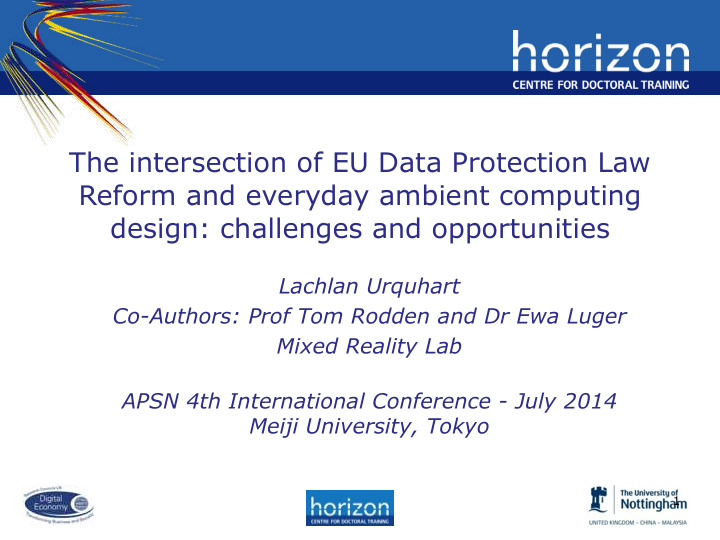



The intersection of EU Data Protection Law Reform and everyday ambient computing design: challenges and opportunities Lachlan Urquhart Co-Authors: Prof Tom Rodden and Dr Ewa Luger Mixed Reality Lab � APSN 4th International Conference - July 2014 Meiji University, Tokyo 1
Outline Legal Challenges (or opportunities?) - Ubicomp – ‘out of the lab’ & ‘into the wild’ - Consent - Informed, Explicit - Data Protection by Design - Consent, preserving human agency & accountability as opportunities for designers to address - DP compliance as requirement of good HCI/system design e.g. alongside usability, intuitiveness
Ubicomp ‘in the wild’ • Ubicomp? • “ Computers that weave themselves into the fabric of everyday life until they are indistinguishable from it ” (Weiser 1991) − Embedded in daily routine − Seamless interactions between computer & human post-PC HCI • “ Unremarkable ” & “ invisible in use ” (Tolmie et al 2002) • Ambient data collection of human data - for contextually aware services
Examples: Public and Private Setting • Home automation: - IoT - wired toasters, fridges & speaking to each other - Energy: Smart meters; NEST Learning thermostat ; Smart Grid - Agent based home energy management - Public Lighting; smart billboards - Quantified Self -Smart scales / Fitbit Ubicomp 2.0 • – Greater agency – Embedded/wearable – ‘knowing’ by inference – linked up communication
Designing for Consent in Europe Current: Article 2 EU Data Protection Directive 1995 ‘freely given’, ‘specific’ and ‘informed’ indication to processing – ‘explicit’ if sensitive personal data. Future: Article 4(8) EU General Data Protection Reform – explicit, via a ‘statement’ or ‘clear affirmative action’ Issue: Collection across public and private contexts – digital and physical space – intimate spaces – bathroom, bedrooms etc - How frequently, duration of consent, when best to ask?
Issues • Design - How to notify/ask? – Sale + service contract with T&Cs does not work – New models… Pop ups on screens? Tailored videos (to knowledge leveL)? Alert sounds? voice feedback? Gaze recognition? Explicit gestures like waves? ** NEST Protect UI problem - waving • Challenges: – Increased agency/ autonomy - consent to all unexpected actions? – Communication between devices - authorise for each device? – Maintaining invisibility/seamless system interactions + obtaining explicit consent = how?
Purpose Limitation and Profiling • Article 6 DPD – ‘purpose limitation principle’ • Use not incompatible with original ‘specified, explicit and legitimate’ purposes of collection • A29 Working Party Opinion 3/2013 - Big data analytics/targeted advertising in mind. • If direct impact on individuals, need: • a) opt-in consent • b) data subject access to profiles being used to target them • c) access to the decision making criteria used in developing the profiles
Issues • Increase transparency of system: • Allow users to interrogate functionality & become more informed - ‘black box’ not sustainable • Design for provenance of data in decision- making e.g. accountability via metadata – Useful for ‘subject access rights’ or future DP rights to deletion/portability • How can ubicomp systems support users to opt in to specific purposes and not others?
Ubicomp in the real world • Sustainable growth? • Lack of public trust?
Data Protection By Design • Cavoukian’s principles including: – privacy embedded into design – visibility & transparency – privacy as default • Article 23 GDPR – ‘state of the art’ – ‘cost of implementation’ – ‘appropriate technical and organisational measures • Who decides limits of these? Different stakeholders, different interests…
Future Work (1) – Opportunities for a priori design solutions • Earlier in innovation process… unlike ex poste PIA’s • ‘Value sensitive design’ (Friedman 1996) and user centered design/HCI • Social values – cultural suitability, psychological well-being, environmental sustainability
Future Work (2) Responsible Innovation Framework (EPSRC) • − Societal impact of technology, ethical implications • Exploring the interface of HCI & DP Law • Usability, intuitiveness, reliability of system… DP compliance? • Empirical studies with different stakeholders - u b i c o m p s y s t e m d e s i g n e r s / u s e r s e g envisioning cards
Thanks for listening Feedback & Questions? � Contact: � Email: lachlan.urquhart@nottingham.ac.uk Twitter: @mooseabyte
Recommend
More recommend